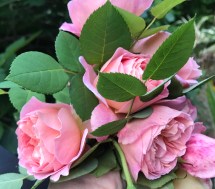
Photo: Jo Hackl
This year presents unique challenges for educators, students, and parents. As we navigate the new normal, why not try a proven technique to reduce stress and increase overall well-being? It turns out that spending time outdoors (even for a few minutes) can help you to do just that. Here’s a summary of some of the growing body of research supporting the benefits of exposure to nature.
Below are some easy ideas to help you incorporate nature into your day. They can not only help to make your day better, but also benefit your entire family.

Photo: Jo Hackl
1. If possible, eat breakfast outside or by a sunny window. Exposure to sunlight helps you wake up and the sights and sounds of nature help set the mood for a productive, calm day.

Photo: Jo Hackl
2. Whether you’re working at home or going to school, include something from nature in your workspace. Even a simple photograph from nature pasted on the inside cover of your notebook can help you relax if you get stressed.
3. Unwind at the end of your school day by taking a walk outside. This helps you clear your mind and relax your body.



Photos: Jo Hackl

Photo: Jo Hackl
4. Consider keeping a nature journal. Your journal doesn’t need to be anything fancy. All you need is something to write on and a pen or pencil to record things that interest you in nature. You might try sitting in the same spot every day and noting how the things you see, hear, feel and touch change over the course of the seasons.
5. Plan your weekend around outdoor activities. It’s easier to maintain social distance outdoors and outdoor activities provide a fun way for your family and friends to make memories. If you’d like to take things a step farther, join me in the practice I’ve maintained for over 25 years—every Sunday I unplug from technology and spend as much time as possible outdoors. My family and I hike. We garden. We take nature photographs. We don’t think about work or school. And that one simple habit makes an enormous difference in our week.

Photo: Jo Hackl
If you can’t get outdoors, you can read books with natural settings. In addition to classics such as Hatchet, My Side of the Mountain, and Island of the Blue Dolphins
Below are some other wonderful books set outdoors:
A Wolf Called Wander by Rosanne Parry takes readers on a journey with a wolf separated from his family who embarks upon a thousand-mile journey to find a new home. Katherine Applegate, Newbery Medal-winning author of The One and Only Ivan, calls it “[r]iveting and lyrical . . . a vibrantly imagined celebration of the natural world.”
Pax by Sara Pennypacker takes readers on an adventure with Peter, who sets out to reunite with his pet fox. The San Francisco Chronicle calls it “at once a wilderness adventure about survival and a philosophical foray into big questions.”
The Skeleton Tree by Iain Lawrence takes readers on an adventure with two boys who must survive on their own in the Alaskan wilderness. The Horn Book Review calls it “[a]n emotionally engaging and heart-pounding read.”
For more information to help you explore the natural world, check out our STEM Tuesday section. You also can find more ideas (and cites to more research supporting the benefits of time in nature) at www.Outdooorosity.org. I grew up in the country and experienced the benefits of spending time outdoors. Years ago, this convinced me to create Outdoorosity as a free resource. These recent months have demonstrated more and more the value of making time to get outdoors to refresh and recharge. And doing so is good for all the people in our lives.









 Kirsten W. Larson used to work with rocket scientists at NASA. Now she writes books for curious kids. She’s the author of
Kirsten W. Larson used to work with rocket scientists at NASA. Now she writes books for curious kids. She’s the author of 


 Carla Mooney loves to explore the world around us and discover the details about how it works. An award-winning author of numerous nonfiction science books for kids and teens, she hopes to spark a healthy curiosity and love of science in today’s young people. She lives in Pennsylvania with her husband, three kids, and dog. When not writing, she can often be spotted at a hockey rink for one of her kids’ games. Find her at
Carla Mooney loves to explore the world around us and discover the details about how it works. An award-winning author of numerous nonfiction science books for kids and teens, she hopes to spark a healthy curiosity and love of science in today’s young people. She lives in Pennsylvania with her husband, three kids, and dog. When not writing, she can often be spotted at a hockey rink for one of her kids’ games. Find her at